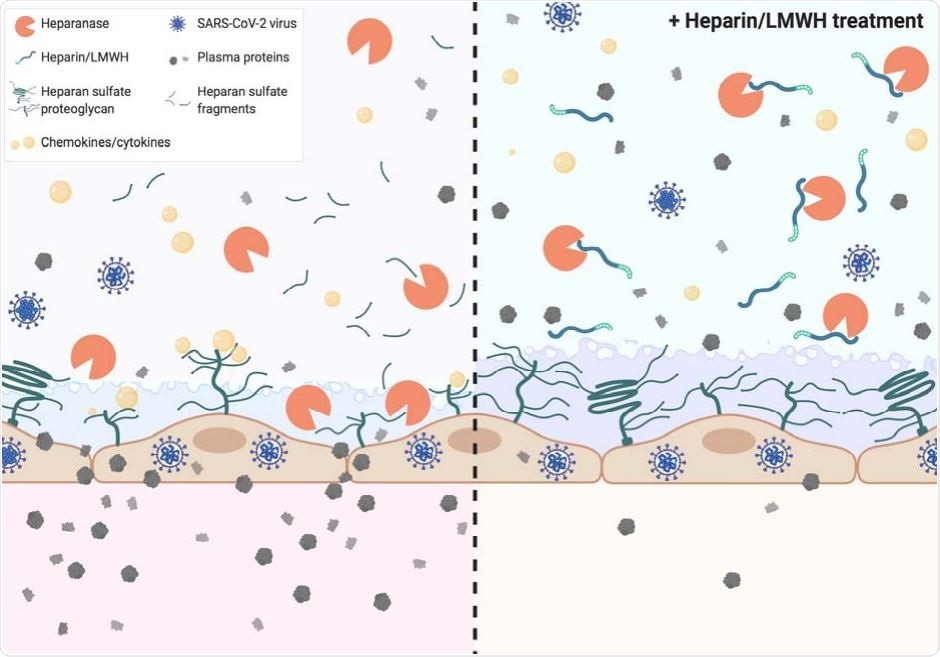The ongoing COVID-19 pandemic is caused by severe acute respiratory syndrome coronavirus 2 (SARS-CoV-2), which led to more than 8.1 million cases and more than 440,00 deaths as of June 17, 2020. Severe manifestations of COVID-19 are often characterized by acute respiratory disease syndrome and proteinuria, both associated with leaky vasculature.

Graphical Abstract

 This news article was a review of a preliminary scientific report that had not undergone peer-review at the time of publication. Since its initial publication, the scientific report has now been peer reviewed and accepted for publication in a Scientific Journal. Links to the preliminary and peer-reviewed reports are available in the Sources section at the bottom of this article. View Sources
This news article was a review of a preliminary scientific report that had not undergone peer-review at the time of publication. Since its initial publication, the scientific report has now been peer reviewed and accepted for publication in a Scientific Journal. Links to the preliminary and peer-reviewed reports are available in the Sources section at the bottom of this article. View Sources
The importance of endothelial integrity
Intact endothelial barrier function is pivotal for the regulation of fluid and protein extravasation, particularly in the lungs and kidneys. Several research studies proposed a paramount role for endothelial cell dysfunction in the pathogenesis of COVID-19 complications, where the degradation of heparan sulfate (i.e., a predominant glycosaminoglycan that covers endothelial cells) takes place.
More specifically, increased activity of the endothelial glycocalyx-degrading enzyme heparanase (HPSE) can compromise the function of the endothelial barrier. The loss of endothelial barrier function due to such heparanase activity has been established for a wide array of inflammatory disease conditions – including sepsis, acute respiratory distress syndrome, and proteinuric kidney disease.
Heparin, which is a prototypical anticoagulant, exerts significant anti-inflammatory effects in animal models and clinical conditions, primarily through interference with the heparan sulfate functions, since both polysaccharides share a highly similar molecular structure.
This is why researchers hypothesized that heparanase contributes to the pathogenesis of COVID-19 and that heparan sulfate may be inhibited with the use of low molecular weight heparins. Consequently, they decided to measure heparanase activity and heparan sulfate levels.
Their study population consisted of 48 COVID-19 patients (admitted to the intensive care unit or designated clinical wards) and ten healthy controls. The activity of heparanase in EDTA-treated plasma samples was determined by an in-house developed activity assay, while heparan sulfate in EDTA-treated plasma samples was quantified by an in house developed competition assay.
Increased heparanase activity and circulating heparan sulfate
The comparison of plasma heparanase activity levels in COVID-19 patients and healthy controls demonstrated that heparanase activity is significantly elevated in COVID-19 patients. Consequently, heparan sulfate plasma levels were also significantly elevated in COVID-19 patients when compared to healthy controls.
"Overall, these results suggest that SARS-CoV-2 infection causes an increase in the activity of heparanase in plasma and an increase in circulating heparan sulfate", study authors emphasize the significance of this finding in their medRxiv paper.
Furthermore, potential associations were assessed between the levels of heparanase activity and the need for intensive care or for mechanical ventilation, but also for lactate dehydrogenase values as a measure of tissue damage, and creatinine values as the proxy of kidney function.
More specifically, plasma heparanase activity and heparan sulfate levels in plasma were significantly higher in all patients compared to healthy controls, regardless of their admission to intensive care unit. Heparan sulfate levels were significantly increased only in those in the intensive care unit, as well as in those necessitating mechanic ventilation.
"These findings reveal that patients with severe COVID-19 disease, such as those admitted to the intensive care department, have higher plasma heparan sulfate activity levels than patients with moderate, such as non-ICU patients, COVID-19 disease", say study authors.
Likewise, patients with increased lactate dehydrogenase values and elevated serum creatinine values also displayed increased plasma activity of heparan sulfate, which adds an additional layer of evidence to the unfavorable clinical presentation of such COVID-19 patients.
Low molecular weight heparins as a potential treatment option
In a nutshell, this multinational cross-sectional study reveals that heparanase activity and heparan sulfate levels are substantially elevated in the plasma of patients with COVID-19, and also associated with the severity of the disease. Could we use this for tailoring better treatment approaches?
"Targeting of heparanase activity could be beneficial for the clinical outcome of COVID-19 patients since it is well established that increased heparanase activity compromises the endothelial glycocalyx and endothelial barrier function and contributes to the establishment of a pro-inflammatory cytokine milieu", say study authors.
Taking into account that there are no clinically approved heparanase inhibitors, further prospective studies that evaluate clinical outcomes of COVID-19 patients treated with therapeutic doses of low molecular weight heparins are urgently needed.
In addition to inhibiting heparanase, these drugs have other functions beneficial for patients with COVID-19, most notably the interference with leukocyte trafficking, neutralization of cytotoxic histones, and high molecular weight kininogen, as well as the reduction of viral entry – making them a very promising addition to our treatment armamentarium.

 This news article was a review of a preliminary scientific report that had not undergone peer-review at the time of publication. Since its initial publication, the scientific report has now been peer reviewed and accepted for publication in a Scientific Journal. Links to the preliminary and peer-reviewed reports are available in the Sources section at the bottom of this article. View Sources
This news article was a review of a preliminary scientific report that had not undergone peer-review at the time of publication. Since its initial publication, the scientific report has now been peer reviewed and accepted for publication in a Scientific Journal. Links to the preliminary and peer-reviewed reports are available in the Sources section at the bottom of this article. View Sources